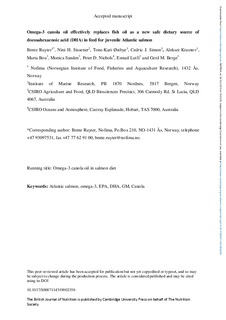Omega-3 canola oil effectively replaces fish oil as a new safe dietary source of docosahexaenoic acid (DHA) in feed for juvenile Atlantic salmon
Ruyter, Bente; Sissener, Nini; Østbye, Tone-Kari K; Simon, Cedric; Krasnov, Aleksei; Bou, Marta; Sanden, Monica; Nichols, Peter D.; Lutfi Royo, Esmail; Berge, Gerd Marit
Journal article, Peer reviewed
Accepted version

Permanent lenke
http://hdl.handle.net/11250/2637822Utgivelsesdato
2019Metadata
Vis full innførselSamlinger
- Articles [3012]
- Publikasjoner fra CRIStin [3070]
Sammendrag
Limited availability of fish oils (FO), rich in n-3 long-chain (≥C20) PUFA, is a major constraint for further growth of the aquaculture industry. Long-chain n-3 rich oils from crops GM with algal genes are promising new sources for the industry. This project studied the use of a newly developed n-3 canola oil (DHA-CA) in diets of Atlantic salmon fingerlings in freshwater. The DHA-CA oil has high proportions of the n-3 fatty acids (FA) 18 : 3n-3 and DHA and lower proportions of n-6 FA than conventional plant oils. Levels of phytosterols, vitamin E and minerals in the DHA-CA were within the natural variation of commercial canola oils. Pesticides, mycotoxins, polyaromatic hydrocarbons and heavy metals were below lowest qualifiable concentration. Two feeding trials were conducted to evaluate effects of two dietary levels of DHA-CA compared with two dietary levels of FO at two water temperatures. Fish increased their weight approximately 20-fold at 16°C and 12-fold at 12°C during the experimental periods, with equal growth in salmon fed the FO diets compared with DHA-CA diets. Salmon fed DHA-CA diets had approximately the same EPA+DHA content in whole body as salmon fed FO diets. Gene expression, lipid composition and oxidative stress-related enzyme activities showed only minor differences between the dietary groups, and the effects were mostly a result of dietary oil level, rather than the oil source. The results demonstrated that DHA-CA is a safe and effective replacement for FO in diets of Atlantic salmon during the sensitive fingerling life-stage.